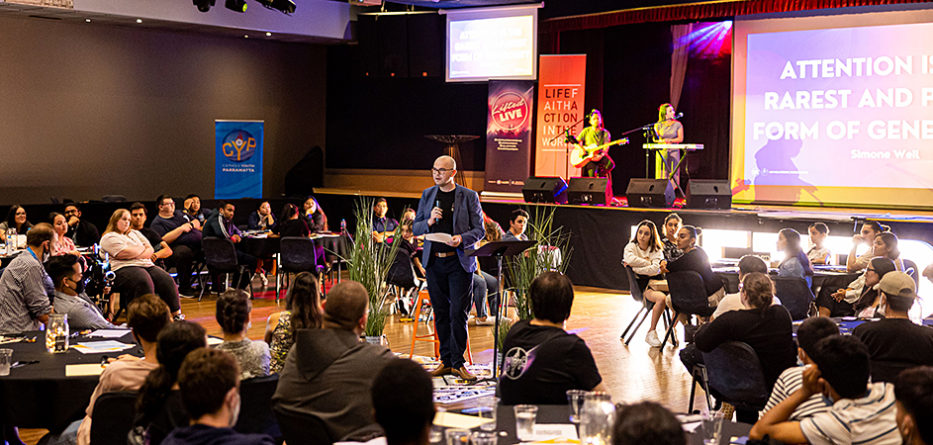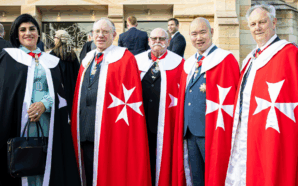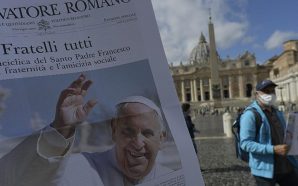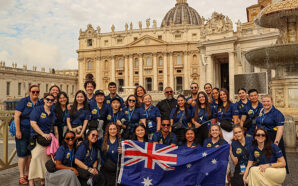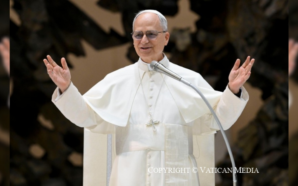At his weekly general audience on May 27, 2015, Pope Francis asked engaged couples to read Alessandro Manzoni’s novel The Betrothed. He knew how such writers, who are neither bishops nor priests, can have much to teach the Church about Christian faith and life. Manzoni’s classic work depicts the troubled love story of Renzo and Lucia. As a “masterpiece on engagement,” it still has important lessons for the youth of today about the heroic endurance that followers of Jesus need, if they are to face suffering and resist even great evil as they live, hoping for the divine justice to come.
In his 2016 apostolic exhortation on love in the family, Amoris Laetitia (Joy of Love), the Holy Father cited Jorge Luis Borges (AL 8) and other modern writers (AL 107, 181). While never considered official teachers for Catholics and other Christians, they have many significant things to teach us, in this case, about family life.
The exhortation broke new ground by citing a film, said to be the pope’s favorite film, Babette’s Feast: “since we were made for love, we know that there is no greater joy than that of sharing good things” (AL 129). Babette’s unselfish sharing brings much joy to those who have lived harsh and constricted lives. Her love breaks them open to the simple joys of life.
To commemorate 700 years since the death of Dante Alighieri, Pope Francis issued an apostolic letter on March 25, 2021: Candor Lucis Aeternae (Brightness of Eternal Light). “Dante,” he wrote in the introduction, “knew how to express with poetic beauty the depth of the mystery of God and love.” We will return below to Dante, and what he achieved as a teacher of Christians and, indeed, of all human beings.
We might add that all men and women, no matter whether like Dante they are baptized or not, no matter what positions they hold in Church or society, are by nature teachers as well as learners. As Bernard Lonergan observes in his classic work Insight, “talking is a basic human art.” We “communicate to others” what we ourselves know.[1]
Vatican II on the teaching role of the laity
Vatican II (1962-65) conveyed an inclusive, even universal view of those who can contribute to the teaching role of the Church. Through being baptized, all Christians share in the triple “office” of Christ as priest, prophet, and king/shepherd. St. John Henry Newman’s insight about the laity receiving this threefold office – and, in particular, the prophetic office – inspired his remarkable essay of 1859, On Consulting the Faithful in Matters of Doctrine.[2]
Others prepared the way for Vatican II’s recognizing what the teaching of laymen and laywomen offers. In Lay People in the Church (French original, 1953),[3] Yves Congar dedicated three chapters to the lay people sharing in the priestly, kingly and prophetic (in that order) functions of Christ. A further book on the laity, coming from another theologian who would also play an important role at Vatican II, Gérard Philips, appeared in 1962 shortly before the Council opened: Pour une Christianisme adulte.[4] One of its chapters expounded the three functions of the laity as “A Priestly, Prophetic, Royal People.”
In the history of general councils of the Church, the Second Vatican Council broke new ground by including explicit teaching on the laity: notably, a chapter in the 1964 Constitution on the Church, Lumen Gentium (Light of the Peoples) (30-38) and the 1965 Decree on the Apostolate of Lay People, Apostolicam Actuositatem (Apostolic Activity). Passages in other Vatican II documents contained further teaching on the laity (e.g. the 1965 Decree on the Church’s Missionary Activity, Ad Gentes (To the Peoples), 15 and 21). None of the previous 20 ecumenical councils had ever offered any such teaching on the life and mission of lay people, in particular, as prophetic teachers.[5]
Chapter 4 of Lumen Gentium elaborates the threefold office of the laity as priests, prophets and kings (in that order). First of all, “Christ Jesus, the supreme and eternal Priest” gives the laity “a share in his priestly office” to offer spiritual worship in the Holy Spirit “for the glory of the Father and the salvation of the world” (LG 34).
Second, Christ, “the great Prophet who proclaimed the kingdom of the Father,” now “fulfills his prophetic office not only through the hierarchy who teach in his name…but also through the laity.” He “establishes them as witnesses (testes)” and “powerful heralds (validi precones) of the faith” (LG 35).
Earlier, Lumen Gentium had characterized Christian parents as being “in their domestic church heralds (precones) of the faith” for their children (LG 11). Pope Francis has stressed the essential role parents play as educators. He was to close his audience on May 20, 2015, by praying that all parents would have the confidence, freedom and courage needed to fulfill this mission as educators.
Third, “the Lord also desires that his kingdom be spread by the lay faithful.” The kingly office of the laity is set out at even greater length than their priestly and prophetic roles (LG 36).
Inasmuch as the baptized faithful share in “the priestly, prophetic and kingly office of Christ,” they “carry out, to the best of their ability, the mission of the whole Christian people in the Church and in the world” (LG 11). They are called to teach (as prophets), sanctify (as priests) and govern (as kings/shepherds).
The authority of laypersons’ teaching
But, since the laity are not “in the sacred ministry,” Lumen Gentium insists that they do not “teach with the authority of Christ” (LG 32). Only the ordained “represent the person of Christ” (LG 37). The Council struggled to maintain a distinction between (a) lay persons participating in the prophetic, teaching mission of Christ and (b) bishops (and their priestly collaborators in the ordained ministry) doing so.
In their prophetic, teaching role, Vatican II acknowledged that the non-ordained faithful are established by Christ as “living instruments,” engaged in evangelization for his kingdom (LG 33). In some real sense, the laity also teach in the name of Christ, enjoy the authority of Christ, and represent the person of Christ. It is primarily through him that they have received a share in “the salvific mission of the Church” (LG 33) and, specifically, in its office of prophetic teaching.
Chapter 4 of Lumen Gentium provided two other useful terms, “the charisms shared by everyone” (LG 30) and “the experience of the laity” (LG 37; italics added). They suggest a credible way for distinguishing (but not separating) the teaching mission of the magisterium and that of the laity. Through episcopal ordination the bishops assume an official teaching role. The personal charisms and experience of the laity can bring “a more profound knowledge of revealed truth” (LG 35) that establishes them as effective teachers in the Church and the world.
At the very end of Vatican II, the Constitution on the Church in the Modern World, Gaudium et Spes (Joy and Hope), strikingly held together the Church and the world for the teaching of lay persons: “the laity are called to participate actively in the entire life of the Church,” as well as “animating the world with the Christian spirit.” “They are to be witnesses to Christ in all circumstances and at the very heart of the human fellowship” (GS 43). This means that lay people exercise their prophetic office as witnesses to Christ in their married and family life (LG 5; AA 11, 30) and in public activity, especially at their place of work (LG 25).
Finally, the Second Vatican Council acknowledged with gratitude “the army of catechists, both [lay] men and women”; their role is of “the highest importance” (AG 17). By definition, catechists are teachers, and should be reckoned among the essential figures in the teaching Church.
Writers and film directors
Unquestionably, Vatican II had much to say about the mission – and, in particular, the teaching mission – of lay persons in and for the Church. But we need to put flesh and blood on this teaching and, like Pope Francis, provide examples of baptized faithful who teach the Church. They belong to “the living tradition” (the Constitution on Divine Revelation, Dei Verbum (DV 12), and play a major role in teaching the divine self-revelation that reached its unique highpoint with Jesus Christ.
We begin with two groups: writers, and then film directors. They are teachers for the Church and are notable voices in the “living tradition” that mediates the divine self-communication.
In a tradition developed by Evagrius Ponticus (345-399) and Gregory the Great (c. 540-604), the seven deadly sins are pride, avarice, lust, envy, gluttony, anger and sloth. Evagrius and then Gregory reworked along these lines the truth of human sinfulness. We need to repent of our sins when receiving the good news of Jesus (Mark 1:15).
Centuries after Gregory, Dante Alighieri (1265-1321) provided a detailed account of the moral life by picturing a long climb up the mountain of Purgatory. It was flanked by seven terraces on which sinners were being cleansed from the seven deadly sins. These sins began with the worst (pride) and ended with the least serious sin of lust. Dante knew the biblical teaching of the Ten Commandments, but judged that the doctrine of the seven deadly sins communicated better.
Dante’s choice proved highly successful. For centuries his Purgatorio proved a vivid handbook for Christians examining their conscience about sins they had committed. Dante helped keep the teaching on the seven deadly sins alive into modern times. Such films as Les sept péchés capitaux ( Nine Directors, 1962) witness to the way in which this traditional doctrine has maintained its power and insight. Many of those who saw the stage version of those sins expressed in silent mime by Marcel Marceau will affirm the same.
The 1993 Catechism of the Catholic Church listed the seven capital sins, which insidiously can engender other sins (CCC. 1866). Elsewhere the Catechism expounds these sins: pride (CCC 1931), avarice (CCC1849), lust (CCC 2541), envy (CCC2553), gluttony (CCC 2290), anger (CCC 2302) and sloth (CCC 2094).
Through his imaginative pilgrimage at Easter 1300 into the other world, Dante had much more to teach the Christian Church than a doctrine about sin. As a brilliant product of divine revelation and human genius, the Divina Commedia remains dense with teaching on the role of natural reason, the Lord’s Prayer, divine and human love, and many other truths of revelation – right up to the closing evocation of the goal of life, the beatific vision of the tripersonal God. No other written work by a layman has enjoyed Dante’s comprehensive teaching impact on Christianity and beyond.
Besides being a classic monument of world literature, the Comedy, as a richly influential, postbiblical text of the teaching Church, is to be classified toward the very top. Along with a book by a priest (soon to become a bishop), the Confessions of St. Augustine, and a work by a priest-theologian, the Summa Theologiae of St. Thomas Aquinas, Dante has supplied one of the major tracts of the teaching Church.
On many Christian artists – such as Sandro Bottticelli and William Blake – Dante exercised a deep influence,[6] confirming that he may arguably be the greatest writer among the Christian laity. There are innumerable other lay men and women who rank among the exponents of the teaching Church. We could mention poets like T. S. Eliot and John Milton, Christian apologists like G. K. Chesterton, C. S. Lewis, Romano Guardini and Dorothy Sayers, and authors of fiction like Georges Bernanos, Miguel de Cervantes, Fyodor Dostoevsky, Flannery O’Connor and Leo Tolstoy. They have helped countless men and women to understand and live the message of Jesus, and so proved themselves teachers of the Church.
Here we should not forget classical women mystics, like Julian of Norwich, Hildegard of Bingen and Catherine of Siena. The contribution to teaching on prayer and other aspects of the spiritual life made by Hildegard, Catherine, Teresa of Avila and Thérèse of Lisieux has led to their being officially recognized as Doctors of the Church. They were never ordained to the priesthood, and remained lay women. Yet they have long been established as creative teachers for the Christian Church and beyond.
Lay people teach through films
In a world where the screen is the dominant art form, we dare not forget films. Some take up biblical narratives directly, like Darren Aronofsky’s Noah (2014), Mel Gibson’s The Passion of Christ (2004), Pier Paolo Pasolini’s The Gospel According to St. Matthew (1964) and Franco Zeffirelli’s Jesus of Nazareth (1977). Other films engage more subtly with the scriptural message, like Denys Arcand’s Jesus of Montreal (1989) and Martin Scorsese’s Silence (2016).
We should not ignore films which depict the life of Christians. Xavier Beauvois’ Of Gods and Men (2010) presented the life and death of nine Trappists killed in 1996 during the Algerian Civil War. Emilio Estevez’s The Way told the story of a doctor who, following the tragic death of his adult son, set out on the camino to Santiago de Compostela and was joined by three fellow pilgrims. Such films belong to the Church’s teaching mission, showing ways in which Christian faith expresses itself in action and worship.
Great films, no less than powerful novels, often tell stories of human redemption. I think of Midnight Cowboy (1969), Three Colors: Blue (1993), Three Colors: Red (1994), Gran Torino (2008) and Four Billboards Outside Ebbing, Missouri (2017). Whether or not we speak here of “pre-evangelization,” such films open up the message of being redeemed through the blood of Christ.
Artists
A vast army of laypersons, including sculptors, architects, creators of icons, painters and weavers of tapestry, have proved effective Christian teachers. Many remain anonymous, but they have taught generation after generation of Christians how to worship, what to believe and how to behave.
Right from the catacombs of early Christianity, artists have taught the church. When Christian art emerged above ground, it produced such educationally rich edifices as the Basilica of St. Mary Major in Rome, the Abbey and Cathedral of Monreale, and Chartres Cathedral. These buildings and their contents remain eloquent witnesses, whose largely unknown creators have transmitted the message of Christ and the demands of Christian living. The stained-glass windows of Chartres Cathedral retell the full sweep of salvation history, with the Old Testament and New Testament in each window mutually interpreting each other.
Paintings, frescoes and mosaics, no less than stained-glass windows, announce, interpret and pay tribute to the Christian gospel. Painters have dwelt on the story of Jesus’ passion, in particular on the institution of the Eucharist. When commenting on Matthew’s Gospel, Ulrich Luz introduced eight portrayals of the Last Supper, from Duccio di Buoninsegna, Leonardo da Vinci and Tintoretto down to an expressionist work of Emil Nolde created in 1909.[7] Artists can focus on the historical institution of the Eucharist or on its present celebration. They convey insights into Jesus’ imminent death as being sacrificial or they can stress the sense of the Last Supper being a fellowship meal. They may never have thought of exercising a teaching role for Christians and others. But in fact their personal talents and commitment equipped them to do just that.
The same has held true of paintings of the crucified Christ. Millions of Christians and others have learned what is meant by the passion and death of Jesus by contemplating Raphael’s Crucifixion (1503), Grünewald’s Isenheim Altarpiece (1516), various works by El Greco, Rouault and Rembrandt, and many striking portrayals of the crucifixion from Africa and Latin America.
We could also illustrate how Caravaggio, El Greco, Grünewald, Michelangelo and Piero della Francesca have depicted and interpreted the risen Jesus. These and other artists have taught the Church what the resurrection of the crucified Jesus means.
Through their personal gifts as painters, baptized lay persons have entered history as eminent teachers of the Christian Church. So too has a Jewish painter, Marc Chagall (1897-1985), whose White Crucifixion was painted after the Kristallnacht of November 9/10, 1938, “the night of the broken glass,” when in Germany and Austria the Nazis destroyed or damaged 7,500 Jewish businesses and close to 1,000 synagogues, arrested up to 30,000 Jewish males, and killed at least 91 Jews. This pogrom anticipated the Second World War and the systematic destruction of the Jewish people in Europe.
In Chagall’s composition a long shaft of light lends beauty to the crucifixion, and a sense of prayerful peace on Christ’s face is enhanced by a prayer shawl. The suffering of Jews fills both sides of the paintings. To the right side of the crucified Christ, a village has been pillaged and set on fire, while a group of refugees flee by boat. To the left, a synagogue goes up in flames. Below the cross, various individuals are running away on foot. A lighted menorah joins the shaft of light, on which Christ lies dead on the cross, and illuminates the fleeing Jews. These details lend some element of beauty and hope to those who suffer with Jesus, their fellow Jew.
Chagall’s White Crucifixion puts on display the sufferings inflicted on Jews, and does so by associating them with the crucified Jesus. It suggests filling out the words of Jesus when he identifies his fellow sufferers: the hungry, the thirsty, strangers, the naked, the sick and prisoners (Matt 25:31-46). Chagall’s painting teaches us to add: “I was a persecuted Jew and you sheltered me.”
Some may query associating a non-baptized Jew, Chagall, with the teaching Church. But a crucified and risen Jew, Jesus himself, remains forever the head of the Church and embodies a living, personal bond with the Jewish people. Their experience continues to teach Christians. They can learn the meaning of Christ’s crucifixion from a memorable Jewish painter, one of Christ’s brothers “in the flesh.”
Composers are teachers
The composers of Christian plainchant and hymns, many of them lay persons but a few bishops and priests, have been outstanding in teaching Christians how to worship, believe and behave. A rich musical tradition based on the Bible flourished in both Eastern and Western Christianity. One of the most beautiful songs of praise offered to the Mother of God in the Byzantine East, the Akathistos, is attributed to St. Romanos the Melodian (d. about 560) or another patriarch of Constantinople. The father of liturgical song in the West, St. Ambrose of Milan (c.340-397), was also a bishop.
But many of those who composed hymns and plainchant were not bishops. The sacred music, which continues to teach congregations everywhere, often derives from those who did not belong to the official magisterium. Those composers have proved eminent leaders in the teaching Church. The Stabat Mater, a dramatic medieval hymn inspired by John 19:25-27 and attributed to a religious brother who was not a priest, describes the suffering of the Virgin Mary during her Son’s crucifixion. It became widely used at the Eucharist and during the Stations of the Cross. Along with the Ave Maria and the Magnificat, the Stabat Mater was set to music by Bach, Brahms, Dvorjak, Gounod, Haydn, Palestrina, Schubert, Verdi, Vivaldi and other famous composers. Not all of them composed settings for each one of these three texts, but some of them composed many scores for one or other of the texts. Palestrina, for instance, left more than 35 versions of the Magnificat. The most celebrated composition of all is arguably a setting by Bach of the Magnificat. What is pertinent for our argument is that only one of the composers named here (Vivaldi) was an ordained priest. The other seven were “only” baptized lay men. Yet they have continued to teach the Christian Church through their compositions.
The Masses composed by Bach, Beethoven, Brahms, Byrd, Haydn, Mozart, Palestrina and other classical composers have helped countless people appreciate the Eucharist, the sacramental mystery at the heart of Christianity. Along with the anonymous composers of plainchant Masses, they have been eminent teachers in the worldwide church. The same holds true of Bach’s St. Matthew’s Passion and George Frederick Handel’s Messiah.
All these works are brought alive by many instrumentalists, vocalists, choirs, directors and conductors, lay persons who also continue to make their indispensable contributions. Local parishes are enriched by musicians and singers. At times their popular sacred music does more to teach the faithful than the priestly homilist.
Conclusion
This article recalls examples that Pope Francis has given of lay persons whom we can recognize as having contributed to the Church’s teaching. He does this in the aftermath of Vatican II, which stressed the prophetic or educative role of parents and catechists.
Some lay persons are richly gifted as communicators and teachers. Their personal charisms can make them preeminent teachers of Christians and others. Their capacity to go beyond the merely conceptual allows them to deploy their imaginations in presenting matters that belong to the life of Christian faith.
Within the Church, the western bishops and eastern exarchs make up the magisterium, and teach officially. At the same time, innumerable lay persons should be recognized as constituting the teaching Church, not only as parents and catechists but also in other ways, such as writers, film makers, artists and composers. They too teach others the truth of the divine self-communication in Christ.
Reproduced with permission from La Civiltà Cattolica.
DOI: La Civiltà Cattolica, En. Ed. Vol. 6, no.2 art. 4, 0322: 10.32009/22072446.0322.4
[1] B. J. F. Lonergan, Insight: A Study of Human Understanding, London, Longmans, 1957, 174.
[2] Cf. J. H. Newman, “On Consulting the Faithful on Matters of Doctrine”, in Rambler, July 1859.
[3] Y. Congar, Lay People in the Church: A Study for a Theology of Laity, London, Bloomsbury, 1957.
[4] G. Philips, Achieving Christian Maturity, Dublin, Gill, 1966, 65-93.
[5] For this teaching on lay persons, see Ormond Rush, The Vision of Vatican II: Its Fundamental Principles, Collegeville, MN, Liturgical Academic, 2019, 269-308.
[6] Dante’s impact on Christian iconography is reflected also in medieval manuscripts, like those held in the Marciana National Library, Venice.
[7] U. Luz, Matthew, vol. 3, Minneapolis, Fortress Press, 2005, 265-72.




